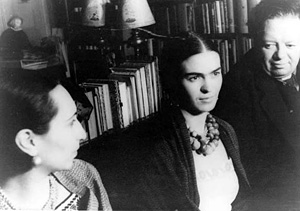 |
 |
 |
 Vallarta Living | Art Talk | December 2006 Vallarta Living | Art Talk | December 2006  
Recently Found Kahlo Skirts to be Shown
 artdaily.org artdaily.org


| | Frida Kahlo (center) and Diego Rivera photographed by Carl Van Vechten in 1932. |
During the summer of 2007, the pieces found inside a trunk that had been forgotten in an unused bathroom will be displayed at Kahlo’s family home-turned-museum for the 100th anniversary of the painter’s birth. "When curators opened the lid to find hundreds of Frida Kahlo’s colorful skirts and blouses, many still infused with the artist’s perfume and cigarette smoke. It has taken two years to log and restore the almost 300 articles," reported the Associated Press.

The trunk of clothes were found in 2004 during a renovation of her family’s home, where she died in 1954.

Frida's paintings attracted the attention of fellow Mexican artist Diego Rivera, whom she later married. They were often referred to as "The Elephant and the Dove" due to their difference in size (Frida's mother, who did not like Diego, came up with this description of them). When they first married, he was 42, 6 ft 1 in. (1.86 m) tall, and 300 pounds (136 kg); she was 22, 5 ft 3 in. (1.6 m) and 98 pounds (44.5 kg).

Their marriage, though loving, was often tumultuous. Both Frida and Diego possessed notoriously fiery temperaments and both had numerous extramarital affairs. Frida did not hide the fact that she was bisexual from Diego, and her husband tolerated her relationships with women (among them actress Josephine Baker because it aroused him. In contrast, her relationships with men made Diego jealous. For her part, Frida was outraged when she learned that Diego had an affair with her younger sister, Cristina Kahlo. The couple eventually divorced but remarried in 1940; their second marriage was as turbulent as the first.

The Associated Press reported that "The clothes are a window to Kahlo’s life. The curators of her museum were struck not only by the actual garments but also by the fact that they still smelled of Kahlo."

"There is still a trace of that very particular odor," said Magdalena Rosen Zweig to Istra Pacheco of the Associated Press, who helped do the restorations. "It’s not mildew or mothballs, but the smell of a person, cigarettes, perfume. It’s a very particular smell, something that makes the clothing come alive. It’s something that helps you understand a person." | 
 | |
 |



